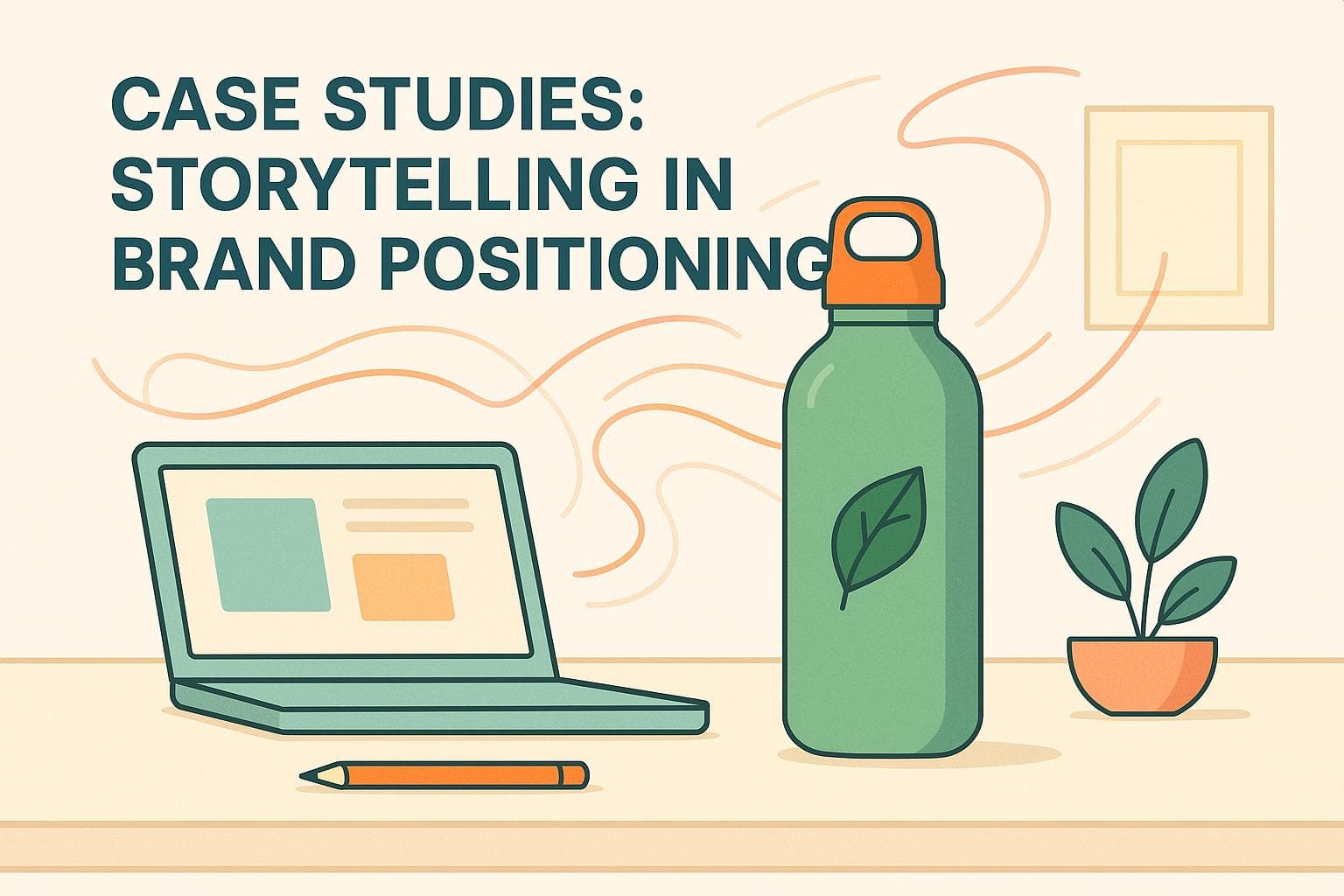
Case Studies: Storytelling in Brand Positioning
Storytelling isn't just a buzzword - it's a proven way for brands to connect with audiences, drive action, and boost growth. Here's why it works and how top brands like Coca-Cola, Nike, Spotify, and Stitchi have used it to their advantage:
- Emotional Connections Matter: Customers who feel connected to a brand are 55% more likely to buy, and 44% share stories that resonate.
- Memorable Stories Stick: People remember stories 22x more than plain facts. Campaigns like Coca-Cola's "Share a Coke" and Nike's "Just Do It" show how relatable narratives build lasting impressions.
- Data-Driven Personalization: Spotify Wrapped turns personal music data into sharable stories, driving massive engagement and app downloads.
- Physical Storytelling: Stitchi transforms brand stories into merchandise, boosting sales and customer loyalty.
Quick Takeaways:
- Coca-Cola: Personalized names on bottles increased U.S. sales by 2% and drove 100M+ social interactions.
- Nike: Inspirational stories grew market share from 18% to 43% over a decade.
- Spotify: Wrapped campaigns saw 400M TikTok views in 3 days.
- Stitchi: Strategic merchandise programs delivered 311% sales growth.
Storytelling builds trust, drives action, and creates emotional bonds that lead to long-term success. Keep reading to see how these brands did it and how you can apply these tactics.
5 Captivating Brand Storytelling Examples
Coca-Cola: The 'Share a Coke' Story
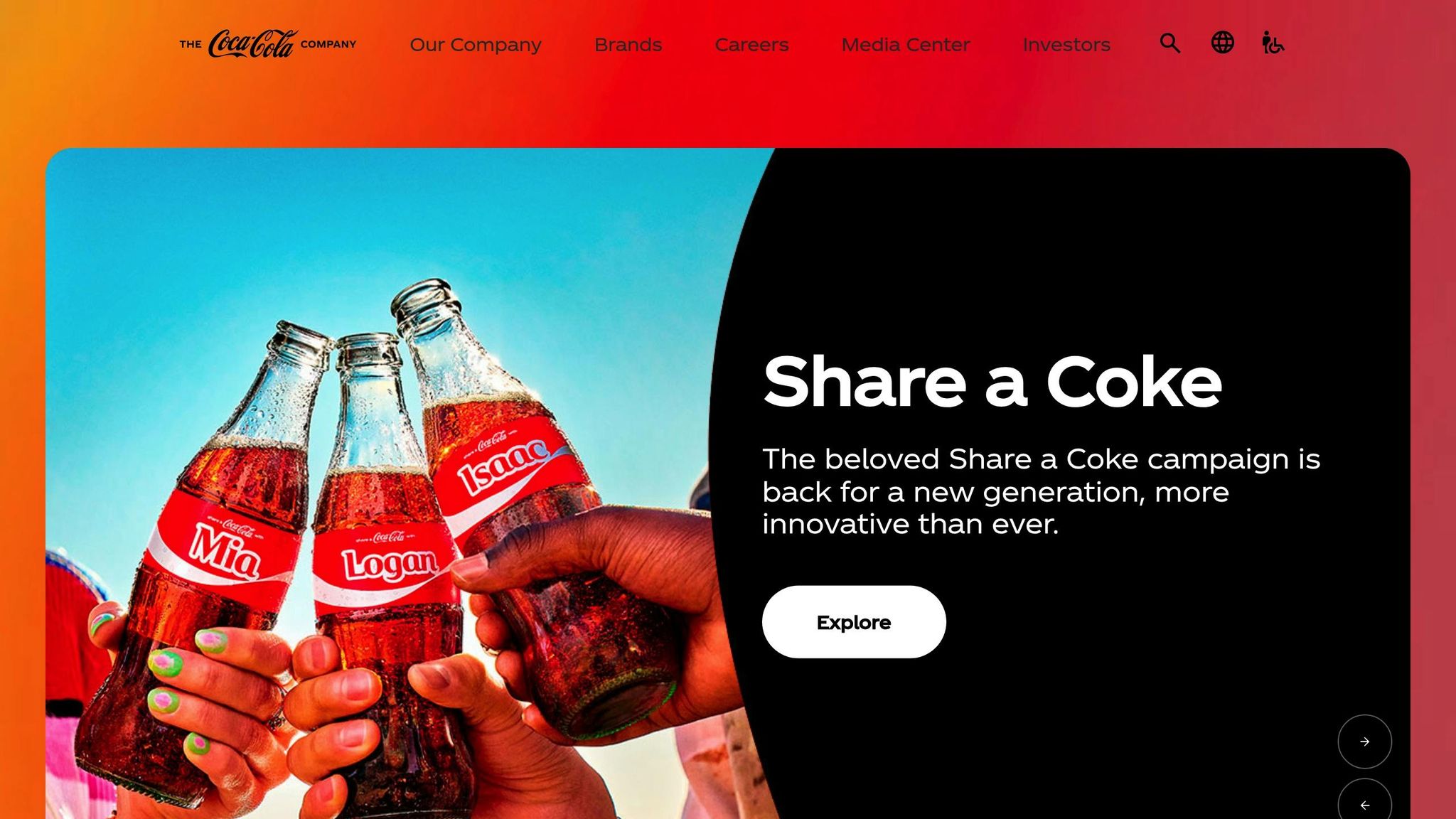
Back in 2011, Coca-Cola shook things up by swapping out its iconic logo for something a lot more personal - people’s names. This simple yet clever idea turned an ordinary soda purchase into a heartfelt, shared experience that captured attention worldwide.
Building Global Connection
The magic of the campaign lay in its focus on friendship and shared moments. Coca-Cola wasn’t just selling a drink; it was tapping into the universal human desire for connection and recognition. This approach struck a chord, driving over 100 million social media interactions and boosting U.S. sales by 2%, a much-needed lift after years of declining revenue [3].
"The iconic Share a Coke is back and supercharged at a global level, celebrating the pure magic that happens when people connect." - Islam ElDessouky, Global VP, Creative at Coca‑Cola [2]
Names and Local Stories
The campaign made its debut in Australia with 150 popular names, and the results were nothing short of spectacular. In just one summer, Coca-Cola sold over 250 million personalized bottles. The impact was evident:
| Metric | Result |
|---|---|
| Facebook traffic increase (first 6 months) | 870% |
| Young adult consumption increase | 7% |
| Sales transactions increase | 3% |
This success story quickly went global. Each market adapted the campaign with names and phrases that resonated locally, making it feel personal no matter where you were. By 2025, the campaign had spread to 120+ countries, evolving to include digital features like personalized video creation through mobile apps and QR codes [2]. These localized touches ensured the campaign’s lasting appeal.
Long-term Brand Impact
The ripple effects of the campaign went far beyond short-term sales. During its peak, Coca-Cola’s market value grew by a staggering $1.8 billion [7].
"Our research showed that while teens and young adults loved that Coca-Cola was big and iconic, many felt we were not talking to them at eye level... By putting first names on the packs, we were speaking to our fans at eye level." - Lucie Austin, Marketing Director for Coca-Cola South Pacific [6]
In its first year alone, the campaign inspired over 500,000 user-generated photos [5]. With consumers sharing their personalized bottles on social media, the campaign became a self-sustaining phenomenon. This approach resonated particularly well with younger audiences, leading to an 11% increase in sales among teens who had previously seen Coca-Cola as outdated [4].
It wasn’t just a campaign; it was a movement that turned customers into storytellers and revitalized the brand’s connection with a new generation.
Nike: Stories of Achievement
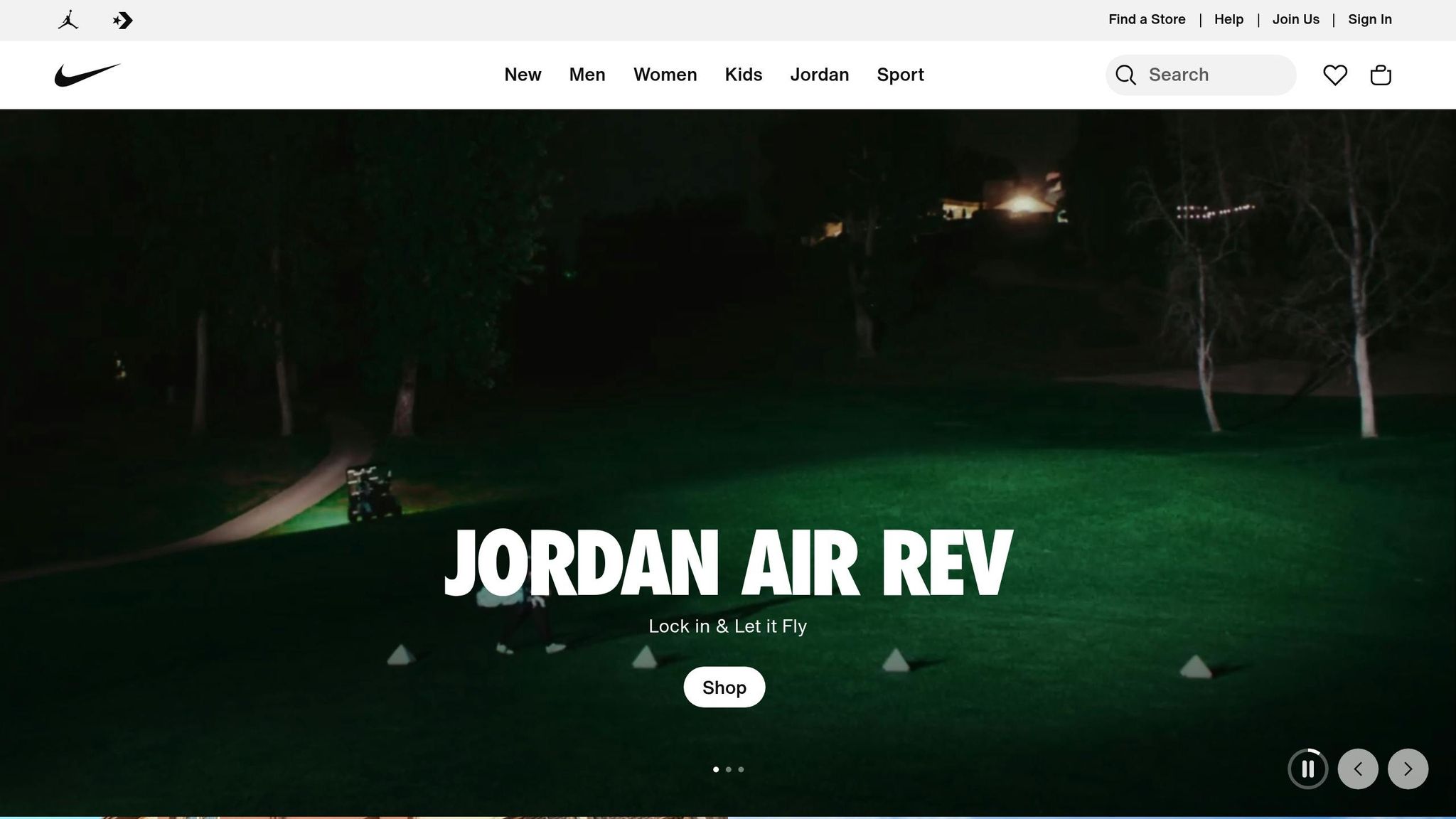
Nike's legendary "Just Do It" campaign, launched in 1988, shifted the focus of marketing from product features to personal stories of triumph. This bold move paid off, with Nike's sales skyrocketing from $877 million to $9.2 billion within just ten years [11]. By celebrating both iconic athletes and everyday individuals, Nike laid the groundwork for a storytelling approach that continues to evolve and inspire.
Athletes and Inspiration
In 1996, Nike featured Michael Jordan in a campaign that highlighted his 9,000 missed shots, emphasizing that failure is often the foundation of success [11]. This narrative resonated deeply, portraying setbacks as an integral part of achievement.
The impact of Nike's storytelling is reflected in their campaign milestones:
| Year | Campaign Focus | Impact |
|---|---|---|
| 1988 | Launch of "Just Do It" | 18% revenue growth |
| 1988–1993 | U.S. Market Expansion | Market share grew from 20% to 37% |
| 1998 | Global Reach | North American sport-shoe share hit 43% |
| 2018 | Social Impact Stories | #JustDoIt inspired 3.5M social posts in one month |
Message Development
Nike's storytelling revolves around overcoming challenges, connecting with audiences who face their own struggles [10]. Instead of focusing on product details, Nike spotlights the transformative journeys of athletes [8].
"We show competition, determination, achievement, fun, and even the spiritual rewards of participating in those activities." - Phil Knight [9]
Over time, Nike expanded its storytelling to include broader social themes. For example, the 2018 campaign featuring Serena Williams highlighted her fight to break barriers in tennis while addressing racial and gender inequalities [11]. By doing so, Nike deepened its connection with audiences, aligning its brand with values that resonate on a personal level.
Market Leadership Results
Nike's narrative-driven strategy has delivered impressive results. Over a decade, the company doubled its North American market share from 18% to 43%. The #JustDoIt campaign alone generated 3.5 million social posts in its first month. Today, Nike's market value exceeds $196 billion, solidifying its role as both a cultural and commercial powerhouse [12][13][11].
These achievements underscore the power of storytelling in building a brand that transcends products. By authentically connecting with consumers' aspirations and values, Nike has created an enduring emotional bond that continues to drive its success.
Spotify: Personal Data Stories
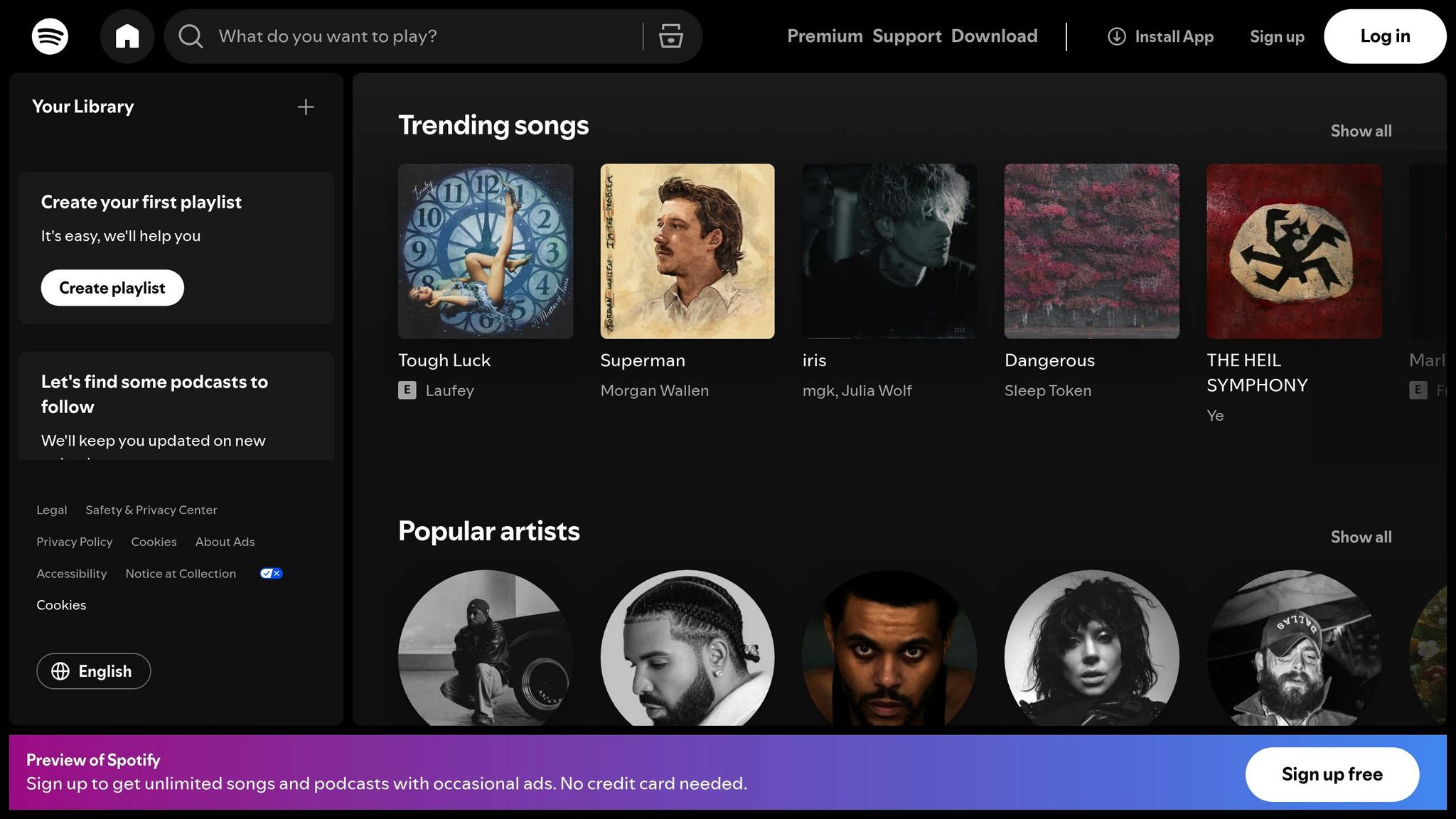
Spotify Wrapped takes listening data and transforms it into personal, shareable stories.
User Data Storytelling
Spotify's secret lies in turning raw listening stats into meaningful narratives that celebrate individuality. Instead of just showcasing numbers, they craft stories that resonate emotionally with users. Here's how they translate data into relatable storylines:
| Data Point | Storytelling Translation |
|---|---|
| Most played track | Your anthem |
| Favorite artist | Your soundtrack |
| Genre combinations | Your musical identity |
"Spotify Wrapped excels at data storytelling because they make user data feel deeply personal and emotionally relevant. Rather than presenting raw numbers, Spotify distills users' listening habits into engaging narratives that highlight individuality - your top artist becomes 'your soundtrack,' your most-played song is 'your anthem,' and your unique combinations of genres are celebrated as your 'musical identity.'" - NoGood [14]
This personalized approach makes users feel seen and sets the stage for widespread engagement.
Multi-channel Distribution
Spotify takes these personal narratives and amplifies them through social sharing. In 2024, they partnered with Google AI's NotebookLM to create AI-generated podcasts tailored to users' favorite tracks and artists. This added a fresh layer to their storytelling strategy [14]. The results? Viral success, especially on TikTok:
| Year | TikTok Views |
|---|---|
| 2022 | 250M |
| 2023 | 320M |
| 2024 | 400M views in 3 days |
This multi-channel approach ensures Wrapped continues to dominate conversations year after year.
Engagement Metrics
The numbers speak for themselves when it comes to Spotify Wrapped's impact:
| Metric | Performance |
|---|---|
| Total Users Engaged (2022) | 156 million |
| Social Shares (2021) | 60 million stories |
| App Download Increase (Dec 2020) | 21% spike |
| Twitter Mention Growth (2020-2021) | 461% |
In 2024 alone, Spotify saw a 40% jump in app engagement during Wrapped week [15]. These results highlight how personalized data stories can strengthen brand loyalty and spark massive online conversations.
sbb-itb-6f489d9
Stitchi: Brand Stories Through Merchandise
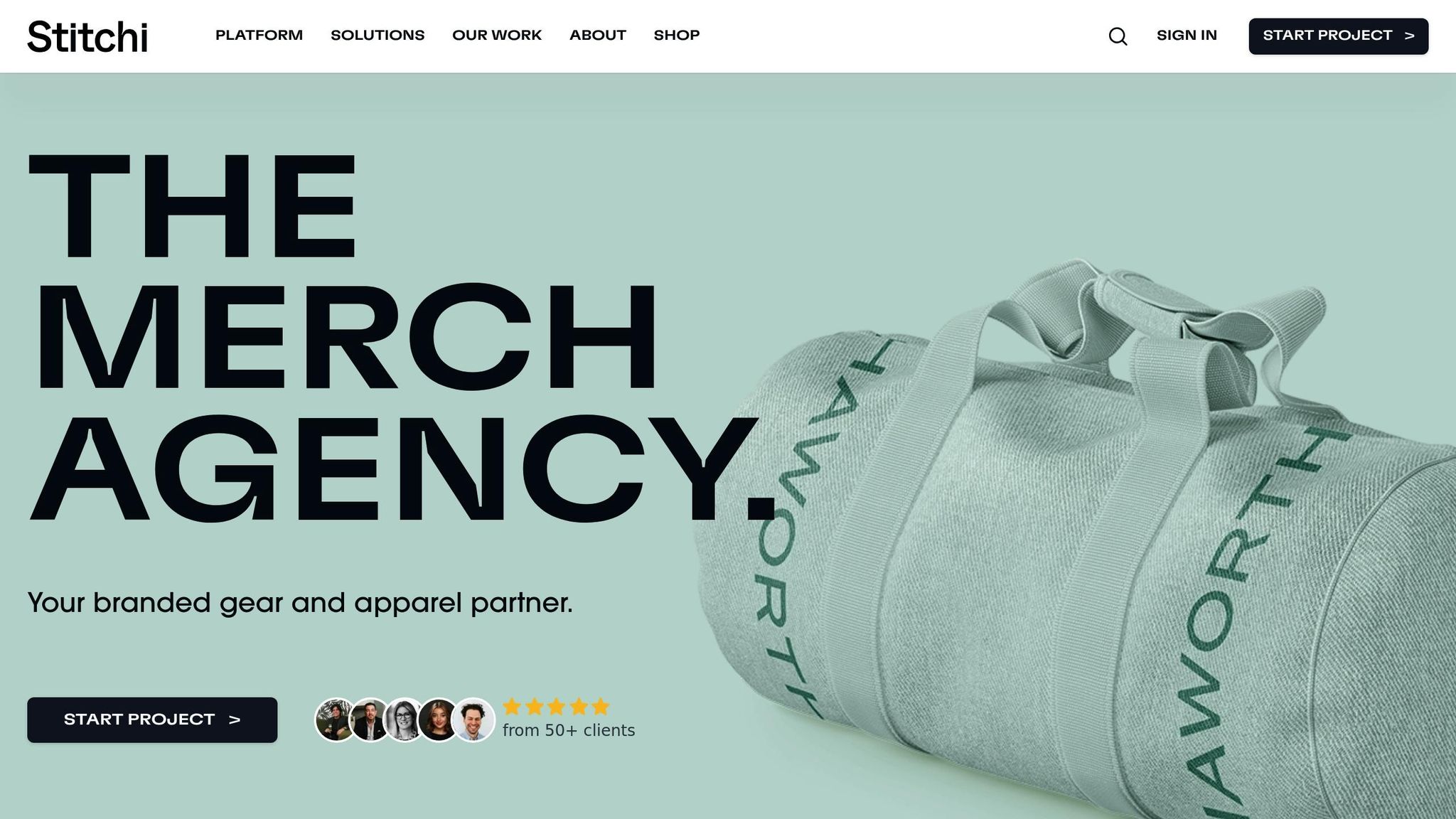
Product Selection Process
Stitchi transforms brand stories into physical experiences by diving deep into a brand's history and community. The goal? To select merchandise that truly reflects its identity. Here's how Stitchi aligns products with brand values:
| Selection Phase | Narrative Integration |
|---|---|
| Brand Discovery | Examining the brand's heritage and story |
| Audience Analysis | Understanding customer perspectives and ties |
| Product Curation | Choosing products that reinforce the brand |
| Design Integration | Adding visual elements that convey the story |
Delivery Experience
After carefully selecting products, Stitchi ensures the delivery process enhances the brand experience. Every detail is designed to leave a lasting impression. Stitchi's tech-driven system guarantees consistent branding, strict quality checks, and real-time tracking.
| Experience Element | Impact Metrics |
|---|---|
| Digital Design Tools | Ensures flawless branding across all items |
| Quality Control | Multi-step verification for top-notch quality |
| Presentation | Custom packaging that tells a story |
| Technology Integration | Real-time tracking for transparency and insights |
"With Stitchi, every product is a faithful ambassador of your brand's identity, resonating with your audience long after the product lands in their hands." [16]
Client Success Stories
Stitchi’s storytelling approach doesn’t just create memorable merchandise - it delivers measurable results. For example:
- Morning Brew: Their referral program added 75,000 new subscribers while cutting Customer Acquisition Costs by 29.40% [18].
-
Noho Hospitality: Stitchi's merchandise program led to major operational gains:
- Procurement Costs: Reduced by 65%
- Delivery Times: 40% faster
- Brand Consistency: Achieved a unified product presentation
- C2 Private Wealth: During a critical rebrand, Stitchi delivered five unique products in just four weeks, strengthening client trust through corporate gifting solutions [18].
These examples show how Stitchi’s strategic merchandise programs amplify brand storytelling and drive tangible business results. Over the past three years, this approach has fueled an impressive 311% growth in sales [17].
Common Success Factors
Story Elements That Work
Crafting a compelling brand story involves specific elements that not only make the narrative memorable but can also improve conversion rates by up to 30% [21].
| Element | Purpose | Impact |
|---|---|---|
| Authenticity | Builds trust | 81% of consumers say trust is critical in their purchasing decisions [20] |
| Emotional Connection | Creates lasting relationships | Encourages deeper engagement and loyalty to the brand |
| Character Development | Makes stories relatable | Helps the audience see themselves in the story |
| Clear Purpose | Guides the narrative | Ensures the message stays consistent across different channels |
By focusing on these elements, brands can systematically create stories that truly connect with their audience.
Story Development Steps
Developing a great brand story requires a step-by-step approach that aligns storytelling with business goals.
-
Understand Your Audience's Values
Start by identifying what your audience cares about. Direct engagement is key - over 40% of consumers will unfollow brands whose values don't align with their own [19]. -
Craft a Core Message
A strong core message is essential for impactful storytelling. Take Apple’s "Shot on iPhone" campaign, for example. By turning a simple product feature into a celebration of creativity, Apple created a narrative that not only highlighted real user experiences but also reinforced its brand as a leader in innovation and artistry. -
Integrate Across Channels
A brand’s story should remain consistent across platforms while adapting to the unique characteristics of each channel."A brand's story starts by uncovering its truth - consumers seek brands that align with their values and expectations." [19]
Airbnb’s "Host Stories" campaign is a great example of this. It successfully highlighted unique host experiences while tying them to the larger theme of meaningful travel and connection.
| Development Phase | Key Activities | Success Metrics |
|---|---|---|
| Discovery | Research audience values and needs | Engagement rates |
| Creation | Develop relatable and authentic stories | Improved brand sentiment |
| Distribution | Tailor stories for different platforms | Increased cross-platform reach |
| Measurement | Monitor performance and gather feedback | Boosted conversion rates |
"Good stories surprise us. They make us think and feel. They stick in our minds and help us remember ideas and concepts in a way that a PowerPoint crammed with bar graphs never can." [22]
This structured process ensures that brand storytelling is not just engaging but also strategically supports the brand’s overall goals. By following these steps, brands can create narratives that not only captivate but also drive meaningful results.
Conclusion
Research shows that storytelling has a powerful effect on brand recall and consumer preferences [23][1]. By examining various case studies, it's clear that effective brand storytelling delivers measurable results by building genuine connections that resonate with customer values.
The benefits of well-planned storytelling are far-reaching. Brands that maintain consistent narratives across all channels can achieve up to 20% revenue growth and see 86% higher consumer preference for brands perceived as authentic [24]. This approach works because storytelling connects with universal emotions while staying true to the brand, influencing 65–70% of purchase decisions [23].
| Story Element | Business Impact |
|---|---|
| Emotional Connection | 23% boost in ad effectiveness [23] |
| Authenticity | 86% higher consumer preference [24] |
| Consistent Narrative | Up to 20% revenue growth [24] |
| Value Alignment | 65–70% of purchase decisions [23] |
Campaigns like Coca-Cola's "Share a Coke", Nike's "Just Do It", and Spotify's "Wrapped" highlight how storytelling goes beyond just sharing a narrative. These examples show how thoughtful storytelling builds trust, strengthens community bonds, and creates unforgettable brand experiences - all of which contribute to long-term business success.
FAQs
How can brands use storytelling to build emotional connections with their audience?
Brands have a powerful tool at their disposal: storytelling. By crafting narratives that resonate with their audience's values, dreams, and experiences, they can build emotional connections that go beyond just selling a product. A well-told story with relatable characters or challenges can spark empathy, making the brand's message stick in people's minds.
When storytelling becomes part of a brand's marketing strategy, it does more than just grab attention - it creates a sense of loyalty and belonging. Take a look at successful examples, and you'll see how storytelling allows brands to come across as relatable and genuine. This, in turn, strengthens customer relationships and keeps people engaged over the long haul.
How does data-driven personalization enhance brand storytelling, and how can brands use it effectively?
Data-driven personalization transforms how brands tell their stories, making messages more relevant and emotionally resonant for their audience. By tapping into customer data - like purchase history, browsing habits, and engagement trends - brands can create narratives that feel uniquely tailored, building trust and strengthening loyalty.
To make the most of this approach, brands can rely on tools such as advanced analytics and AI to extract meaningful insights. This might mean tweaking campaigns in real time, using sentiment analysis to gauge audience emotions, or spotting trends that align stories with customer interests. The outcome? A storytelling approach that feels personal, timely, and deeply connected, fostering stronger relationships with your audience.
What makes a brand story unforgettable and effective across different platforms?
A memorable brand story weaves together genuine connections, emotional impact, and a unified message. Staying true to your brand's core values and mission forms the foundation of this connection, helping audiences feel that your story is real and relatable.
When your story taps into emotions, it leaves a lasting impression, encouraging loyalty and deeper engagement. But none of this works without consistency - your brand's narrative needs to feel seamless across every platform, reinforcing trust and solidifying your identity. By incorporating themes your audience can relate to and crafting a clear, compelling storyline, your brand story becomes more than just words - it becomes an experience that resonates with their values and goals.